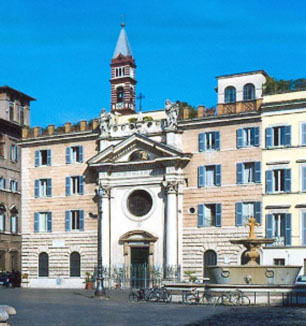
The Piazza Farnese
The Piazza and the Palazzo Farnese
 The Area: The piazza is a beautiful, typical Roman square, situated just one street away from the more hectic Campo dei Fiori. In the past, both squares combined to form one large open space.
The Area: The piazza is a beautiful, typical Roman square, situated just one street away from the more hectic Campo dei Fiori. In the past, both squares combined to form one large open space.
The two fountains at the centre of the square were created from granite bathtubs taken from the ancient Baths of Caracalla. Each fountain is crowned with a stone sculpted iris, the symbol of the Farnese family who were responsible for the Farnese Palace that gives the square its name.
 Palazzo Farnese: The piazza is dominated by the Palazzo Farnese, a Late Renaissance palace commissioned by Cardinal Allessandro Farnese, who would later become Pope Paul III. Construction started in 1514 after a design by Antonio da Sangallo the Younger. When he died in 1546, Michelangelo took over the project and added several new elements to the design such as the balcony over the central doorway and the three metre wide cornice which casts a shadow over the front of the building. Michelangelo also started implementing a plan to connect the palace with Villa Farnesina across the river Tiber which runs behind and parallel to the palazzo, also owned by the Farnese family. It was never completed and the only section that was built is the elegant arch across Via Giulia at the rear of the palazzo.
Palazzo Farnese: The piazza is dominated by the Palazzo Farnese, a Late Renaissance palace commissioned by Cardinal Allessandro Farnese, who would later become Pope Paul III. Construction started in 1514 after a design by Antonio da Sangallo the Younger. When he died in 1546, Michelangelo took over the project and added several new elements to the design such as the balcony over the central doorway and the three metre wide cornice which casts a shadow over the front of the building. Michelangelo also started implementing a plan to connect the palace with Villa Farnesina across the river Tiber which runs behind and parallel to the palazzo, also owned by the Farnese family. It was never completed and the only section that was built is the elegant arch across Via Giulia at the rear of the palazzo.
After Michelangelo’s death in 1564, the Farnese Palace was finished by Giacomo della Porta who worked on the building until 1589. Much of the structure was built with materials taken from the Baths of Caracalla and the Colosseum. Many of the Colosseum's outer arches were destroyed in the process.
From 1626, the palace remained empty and abandoned for 20 years, until Pope Alexander allowed Queen Christina of Sweden to lodge in the palace for several months, but she "proved a tenant from hell". After her departure for Paris, the papal authorities discovered that her unruly servants not only had stolen the silver, tapestries, and paintings, but also had "smashed up doors for firewood" and removed sections of copper roofing.
In Puccini's opera Tosca, set in Napoleonic Rome, the heroine's confrontation with the malevolent Chief of Police, Scarpia, takes place in Palazzo Farnese.
The Farnese line died out in the 18th century and the palace fell into the hands of the Bourbons, then in 1874 it became the property of the French Government. Mussolini 'ransomed' it in 1936, but after the war the French Embassy moved in on a 99-year lease, for which they pay the Italian government a symbolic fee of 1 euro per month. Until 2012 this meant the palace was closed to the public, but after a temporary exhibit proved enormously popular, the embassy decided to organise guided tours, which can be booked on-line at www.inventerrome.com.
 A medieval bullfight
A medieval bullfight
in the Piazza Farnese
 Saint Bridget’s Church: To the right of the Farnese Palace is a small Swedish church dedicated to Saint Bridget of Sweden, who traveled to Rome in 1350 where she started a new order, the Brigidines. In 1354 Bridget moved to a house on the Farnese square where she lived until her death in 1373. The house was later converted into a church dedicated to the Saint. The current Baroque facade dates from the 17th century.
Saint Bridget’s Church: To the right of the Farnese Palace is a small Swedish church dedicated to Saint Bridget of Sweden, who traveled to Rome in 1350 where she started a new order, the Brigidines. In 1354 Bridget moved to a house on the Farnese square where she lived until her death in 1373. The house was later converted into a church dedicated to the Saint. The current Baroque facade dates from the 17th century.
The church convent provides accommodation and the nuns from the convent, easily recognised by their black and white banded headpieces, are often seen scurrying about the area.
To the left of the Palazzo Farnese, the Via del Mascherone runs through to the river. At the end is the start of the Via Giulia, lined with an array of extraordinary churches and cultural buildings, as well as some of the fanciest homes in Rome. (see my separate page)
... back to top of page
